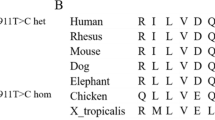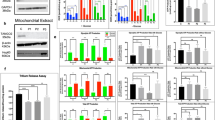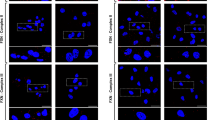Abstract
Friedreich's ataxia (FRDA) is an autosomal recessive degenerative disorder that primarily affects the nervous system and heart. Patients with FRDA have point mutations or trinucleotide repeat expansions in both alleies of FRDA, which encodes a protein termed frataxin. We show that the yeast frataxin homologue, which we have named YFH1, localizes to mitochondria and is required to maintain mitochondrial DMA. The YFH1-homologous domain of frataxin functions in yeast and a disease-associated missense mutation of this domain, or the corresponding domain in YFH1, reduces function. Our data suggest that mitochondrial dysfunction contributes to FRDA pathophysiology.
This is a preview of subscription content, access via your institution
Access options
Subscribe to this journal
Receive 12 print issues and online access
$209.00 per year
only $17.42 per issue
Buy this article
- Purchase on Springer Link
- Instant access to full article PDF
Prices may be subject to local taxes which are calculated during checkout
Similar content being viewed by others
References
Dürr, A. et al. Clinical and genetic abnormalities in patients with Friedreich's ataxia. N. Engl. J. Med. 335, 1169–1175 (1996).
Barbeau, A. Friedreich's ataxia, 1980: an overview of the pathophysiology. Can. J. Neurol. Sci. 7, 455–468 (1980).
Barbeau, A., Quebec cooperative study of Friedreich's ataxia: 1974–1984—10 years of research. Can. J. Neurol. Sci. 11, 646–660 (1984).
Duclos, F., Rodius, F., Wrogemann, K., Mandel, J.-L. & Koenig, M. Friedreich ataxia region: characterization of two novel genes and reduction of the critical region to 300 kb. Hum. Mol. Genet. 3, 909–914 (1994).
Montermini, L. et al. The Friedreich ataxia critical region spans a 150-kb interval on chromosome 9q13. Am. J. Hum. Genet. 57, 1061–1067 (1995).
Campuzano, V. et al. Friedreich's ataxia: autosomal recessive disease caused by an intronicGAA triplet repeat expansion. Science 271, 1423–1427 (1996).
Nakai, K. & Kanehisa, M. A knowledge base for predicting protein localization sites in eukaryotic cells. Genomics 14, 897–911 (1992).
Tzagaloff, A. & Diekmann, C.L. PET genes of Saccharomyces cerevisiae. Microbiol. Rev. 54, 211–225 (1990).
Johns, D.R. Mitochondrial DNA and disease. N. Engl. J. Med. 333, 638–644 (1995).
Mastrogiacomo, F. et al. Immunoreactive levels of a-ketoglutarate dehydrogenase subunits in Friedreich's ataxia and spinocerebellar ataxia type 1. Neurodegeneration 5, 27–33 (1996).
LaMarche, J.B., Cote, M. & Lemieux, B. The cardiomyopathy of Friedreich's ataxia: morphological observations in 3 cases. Can. J. Neurol. Sci. 7, 389–396 (1980).
Koobs, D.H., Schultz, R.L. & Jutzy, R. The origin of lipofuscin and possible consequences to the myocardium. Arch. Pathol. Lab. Med. 102, 66–68 (1978).
Tappel, A.L. Vitamin E and free-radical peroxidation of lipids. Ann. N.Y. Acad. Sci. 203, 12–28 (1972).
Ouahchi, K. et al. Ataxia with isolated vitamin E defeciency is caused by mutations in the cc-tocopherol transfer protein. Nature Genet. 9, 141–145 (1995).
Luft, R. The development of mitochondria! medicine. Biochim. Biophys. Acta 1271, 1–6 (1995).
Suomalainen, A. et al. An autosomal locus predisposing to deletions of mitochondrial DNA. Nature Genet. 9, 146–151 (1995).
Zeviani, M. Nucleus-driven mutations of human mitochondrial DNA. J. Inherited Metab. Dis. 15, 456–471 (1992).
Myers, A.M., Rape, L.K. & Tzagoloff, A. Mitochondrial protein synthesis is required for maintenance of intact mitochondrial genomes in Saccharomyces cerevisiae. EMBO J. 4, 2087–2092 (1985).
Genga, A., Bianchi, L. & Foury, F. A nuclear mutant of Saccharomyces cerevisiae deficient in mitochondrial DNA replication and polymerase activity.J. Biol. Chem. 261, 9328–9332 (1986).
Mueller, D.M. et al. Temperature sensitive pet mutants in yeast Saccharomyces cerevisiae that lose mitochondrial RNA. Curr. Genet. 11, 359–367 (1987).
Sanyal, A. et al. Heat shock protein HSP60 can alleviate the phenotype of mitochondrial RNA-deficient temperature-sensitive mna2 pet mutants. Mol. Gen. Genet. 246, 56–64 (1995).
Carvajal, J.J. et al. The Friedreich's ataxia gene encodes a novel phosphatidylinositol-4-phosphate 5-kinase. Nature Genet. 14, 157–162 (1996).
Carvajal, J.J. et al. Friedreich's ataxia: a defect in signal transduction? Hum. Mol. Genet. 4, 1411–1419 (1995).
Matsumoto, M. et al. Ataxia and epileptic seizures in mice lacking type 1 inositol 1,4,5-trisphosphate receptor. Nature 379, 168–171 (1996).
Babcock, M. et al. Regulation of mitochondrial iron accumulation by Yfhlp, a putative homolog of Frataxin. Science 276, 1709–1712 (1997).
Simon, M. & Faye, G. Steps in processing of the mitochondrial cytochrome oxidase subunit I pre-mRNA affected by a nuclear mutation in yeast. Proc. Natl. Acad. Sd. USA 81, 8–12 (1984).
Protocols in Molecular Biology (eds Ansubel, F.M. et al.) (John Wiley & Sons, New York, 1995).
Baudin, A., Ozier-Kalogeropoulos, O., Denouel, A., Lacroute, F. & Cullin, C. A simple and efficient method for direct gene deletion in Saccharomyces cerevisiae. Nucleic Acids Res. 21, 3329–3330 (1993).
Sikorski, R.S. & Hieter, P. A system of shuttle vectors and yeast host strains designed for efficient manipulation of DNA in Saccharomyces cerevisiae. Genetics 122, 19–27 (1989).
Roth, M.B., Zahler, A.M. & Stolk, J.A. A conserved family of nuclear phosphoproteins localized to sites of polymerase II transcription. Cell Biol. 115, 587–596 (1991).
Rose, M.D., Winston, F. & Hieter, P. Methods in Yeast Genetics (Cold Spring Harbor Laboratory, Cold Spring Harbor, N. Y., 1990).
Garn, H., Krause, H., Enzmann, V. & Drossier, K. An improved MTT assay using the electron-coupling agent menadione. J. Immunol. Methods 168, 253–256 (1994).
Jahn, B., Martin, E., Stueben, A. & Bhakdi, S. Susceptibility testing of Candida albicans and Aspergillus species by a simple microtiter menadione-augmented 3-(4,5-dimethyl-2-thiazolyl)-2,5-diphenyl-2H-tetrazolium bromide assay. J. Clin. Microbiol. 33, 661–667 (1995).
Author information
Authors and Affiliations
Corresponding author
Rights and permissions
About this article
Cite this article
Wilson, R., Roof, D. Respiratory deficiency due to loss of mitochondrial DNA in yeast lacking the frataxin homologue. Nat Genet 16, 352–357 (1997). https://doi.org/10.1038/ng0897-352
Received:
Accepted:
Issue Date:
DOI: https://doi.org/10.1038/ng0897-352
This article is cited by
-
Neurodegenerative disorders associated with genes of mitochondria
Future Journal of Pharmaceutical Sciences (2021)
-
Coenzyme Q10 a mitochondrial restorer for various brain disorders
Naunyn-Schmiedeberg's Archives of Pharmacology (2021)
-
The mitochondrial protein frataxin is downregulated in hemodialysis patients
Clinical and Experimental Nephrology (2013)
-
Iron behaving badly: inappropriate iron chelation as a major contributor to the aetiology of vascular and other progressive inflammatory and degenerative diseases
BMC Medical Genomics (2009)
-
A Novel Mitochondrial Heteroplasmic C13806A Point Mutation Associated with Iranian Friedreich’s Ataxia
Cellular and Molecular Neurobiology (2009)



